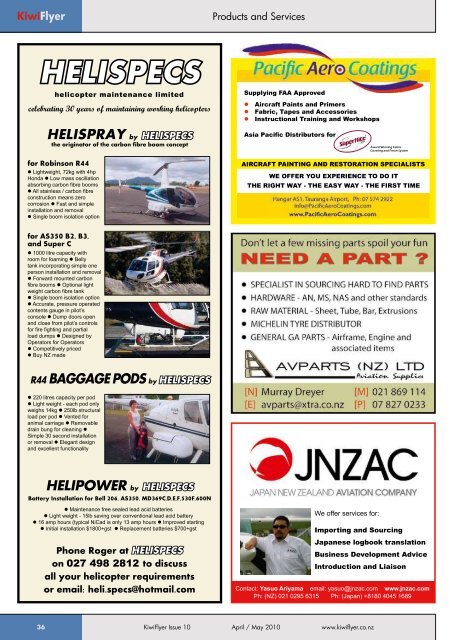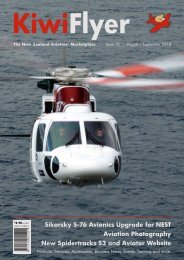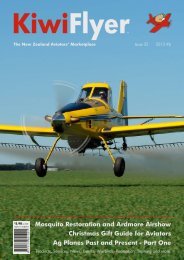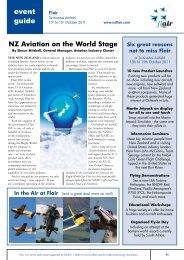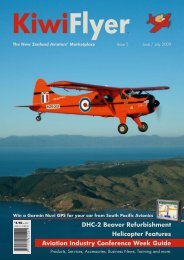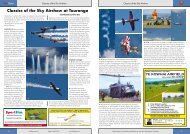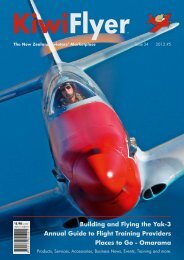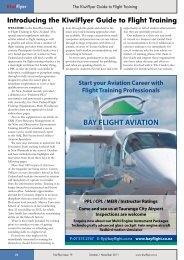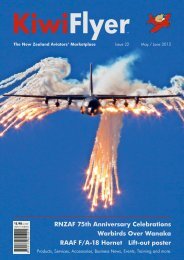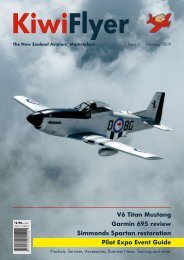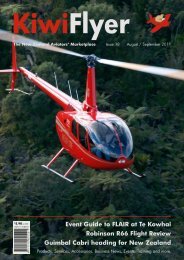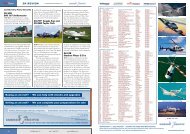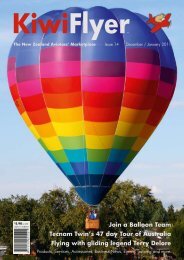You also want an ePaper? Increase the reach of your titles
YUMPU automatically turns print PDFs into web optimized ePapers that Google loves.
<strong>Kiwi</strong><strong>Flyer</strong> Products and Services Sport and Recreation<br />
Gliding Landouts<br />
HELISPECS<br />
Contributed by Jill McCaw<br />
helicopter maintenance limited<br />
celebrating 30 years of maintaining working helicopters<br />
HELISPRAY by HELISPECS<br />
the originator of the carbon fibre boom concept<br />
for Robinson R44<br />
• Lightweight, 72kg with 4hp<br />
Honda • Low mass oscillation<br />
absorbing carbon fibre booms<br />
• All stainless / carbon fibre<br />
construction means zero<br />
corrosion • Fast and simple<br />
installation and removal<br />
• Single boom isolation option<br />
for AS350 B2, B3,<br />
and Super C<br />
• 1000 litre capacity with<br />
room for foaming • Belly<br />
tank incorporating simple one<br />
person installation and removal<br />
• Forward mounted carbon<br />
fibre booms • Optional light<br />
weight carbon fibre tank<br />
• Single boom isolation option<br />
• Accurate, pressure operated<br />
contents gauge in pilot’s<br />
console • Dump doors open<br />
and close from pilot’s controls<br />
for fire fighting and partial<br />
load dumps • Designed by<br />
Operators for Operators<br />
• Competitively priced<br />
• Buy NZ made<br />
R44 BAGGAGE PODS by HELISPECS<br />
• 220 litres capacity per pod<br />
• Light weight - each pod only<br />
weighs 14kg • 250lb structural<br />
load per pod • Vented for<br />
animal carriage • Removable<br />
drain bung for cleaning •<br />
Simple 30 second installation<br />
or removal • Elegant design<br />
and excellent functionality<br />
HELIPOWER by HELISPECS<br />
Battery Installation for Bell 206, AS350, MD369C,D,E,F,530F,600N<br />
• Maintenance free sealed lead acid batteries<br />
• Light weight - 15lb saving over conventional lead acid battery<br />
• 16 amp hours (typical NiCad is only 13 amp hours • Improved starting<br />
• Initial installation $1800+gst • Replacement batteries $700+gst<br />
Phone Roger at HELISPECS<br />
on 027 498 2812 to discuss<br />
all your helicopter requirements<br />
or email: heli.specs@hotmail.com<br />
Supplying FAA Approved<br />
• Aircraft Paints and Primers<br />
• Fabric, Tapes and Accessories<br />
• Instructional Training and Workshops<br />
Asia Pacific Distributors for<br />
We offer services for:<br />
Award Winning Fabric<br />
Covering and Finish System<br />
AIRCRAFT PAINTING AND RESTORATION SPECIALISTS<br />
WE OFFER YOU EXPERIENCE TO DO IT<br />
THE RIGHT WAY - THE EASY WAY - THE FIRST TIME<br />
Importing and Sourcing<br />
Japanese logbook translation<br />
Business Development Advice<br />
Introduction and Liaison<br />
Contact: Yasuo Ariyama email: yasuo@jnzac.com www.jnzac.com<br />
Ph: (NZ) 021 0295 6315 Ph: (Japan) +8180 4045 1689<br />
USA<br />
IN A GLIDER every landing is a forced landing. Gliders don’t get<br />
to go around again and even motor gliders who sometimes fly long<br />
distances using sustainer motors don’t land with engines running.<br />
Glider pilots therefore learn to make every landing precise and<br />
controlled.<br />
A glider circuit is not like the wide square circuit used by<br />
powered planes. Our circuits are closer in to the airfield or landing<br />
site and we control our descent rate with spoilers or airbrakes on<br />
the wings. We aim to land at stall speed + half windspeed + 10kts<br />
and rather than follow our instruments we are taught to judge our<br />
descent by keeping a constant angle to our aiming point. In training<br />
we are taught that this is 45˚, that being an easy angle to visualise,<br />
but in practise 45˚ is too steep for anything other than a high wind<br />
situation. About 30˚ is more realistic. The judgement of height and<br />
distance from the airfield becomes instinctive with training. This<br />
awareness, along with an instinctive judgement of airspeed are<br />
crucial for accurate landings. Generally, training gliders on a still day<br />
land at around 35 to 40 kts.<br />
Another fact of life for gliders is landouts. Gliders can fly long<br />
distances cross country with distances over 1000km possible in a<br />
day. But gliders of course don’t have an assured source of lift so<br />
landing away from the home airfield is always possible. Landing out<br />
on farm strips and farm paddocks is normal. If there is not enough<br />
lift, for instance at the end of a day when convection is shutting<br />
down, then a landout is inevitable.<br />
Landouts contain an element of risk. Until your wheel is actually<br />
on the ground you can’t be exactly sure what you are going to find.<br />
What looks like a nice firm strip may be pockmarked with rabbit<br />
holes, hide rocks in the grass, have a single electric fence wire across<br />
it or what looks like grass may actually be a crop that is several feet<br />
high. Choosing good landing areas is a learned skill. Obstacles, on<br />
the ground and on approach, slope, wind speed and direction are<br />
crucial things to note. While ensuring the safest possible landing<br />
site is the pilot’s first priority, in the back of the pilot’s mind are<br />
considerations such as whether the size of the paddock/strip allows<br />
the possibility of an aero-tow retrieve. Or if an aero-tow will not be<br />
possible then how close is a road for access with the trailer There<br />
are many jokes too about farmer’s daughters providing hospitality<br />
and beer for a stranded pilot awaiting his crew. Some of the stories<br />
are actually true. There is a frequently used strip near Lake Ohau in<br />
the Mackenzie Basin where the local family’s teenage daughters and<br />
friends are excitedly waiting for the landed out pilot to be Richie<br />
McCaw. This hasn’t happened yet.<br />
Land out etiquette says that the pilot must contact the land<br />
owner as soon as possible to let them know they are on his property<br />
and check that they are happy with retrieve arrangements. Once<br />
retrieved, a follow up thank you and gift such as a bottle of wine<br />
should be sent. We want landowners to be as happy to have us. as<br />
we are grateful to have the use of their landing area.<br />
Retrieving gliders can sometimes be an adventure. Gliders, like<br />
model aeroplanes, pull apart easily to fit neatly in their trailers with<br />
wings tucked in next to the fuselage. It is always fun and a good<br />
learning experience to go along on retrieve trips and see where<br />
other people have landed and how they coped with the site. Plus the<br />
pilot is supposed to shout his crew dinner at the very least.<br />
For more information on gliding or to subscribe to SoaringNZ,<br />
visit the Gliding New Zealand website, www.gliding.co.nz<br />
Gliders can land in some very scenic places.<br />
Piako Gliding Club’s two seater on the surf beach at Raglan – the author was<br />
one of the pilots. Retrieving this glider was an epic 5 hour adventure.<br />
A safe landout may still cause other problems. This glider landed in a<br />
ploughed paddock, filling the wheel well with dirt. David Hirst photos.<br />
Landout retrievals often require the support of several friends. The pilot is<br />
expected o shout his crew dinner at the very least.<br />
36 <strong>Kiwi</strong><strong>Flyer</strong> Issue 10 April / May 2010 www.kiwiflyer.co.nz<br />
Are you contacting an advertiser Please mention that you saw them in <strong>Kiwi</strong><strong>Flyer</strong>. 37


